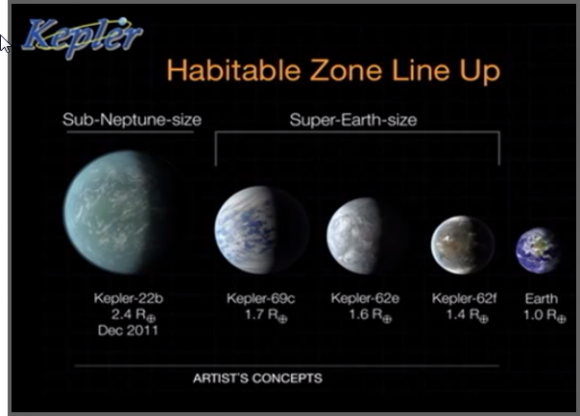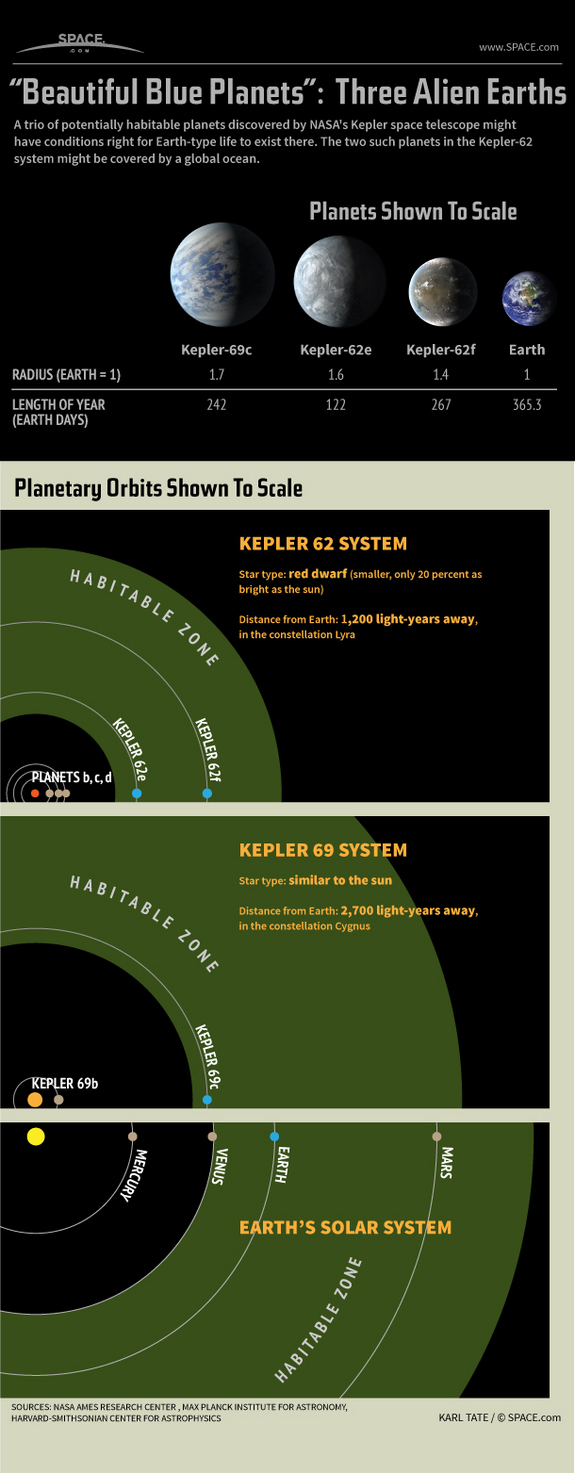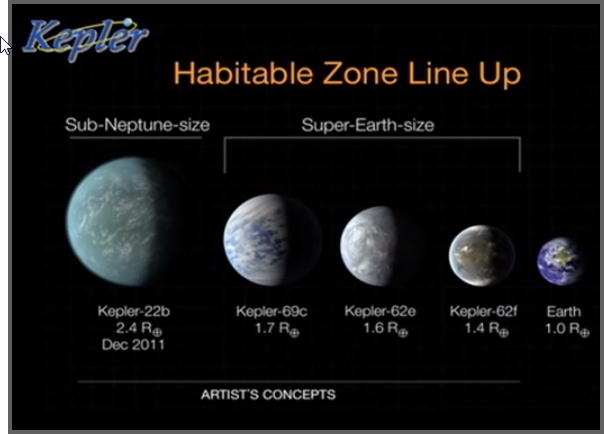aNewDomain.net — “Just as an introduction, this is really cool,” says astronomer and NASA Ames center director Pete Worden. There’s an understatement. At the news conference Worden opened today, NASA astrophysicists and researchers announced that the Kepler space telescope has discovered two new planetary systems and three potentially habitable super-Earth-sized planets that could have the clime and water to host humans. The three newly discovered habitable planets are the most exciting discoveries in the exoplanet search so far, NASA said.
Scientists announced the discovery of seven new exoplanets in all today.
Kepler-69c in particular, scientists say, is an extraordinarily exciting discovery. It is the best candidate yet — in terms of size and, maybe, climate — to be a human-habitable planet. The list of exoplanets is growing.
The three potentially habitable planets Kepler discovered, NASA says, are closer to Earth-size than any exoplanets so far discovered — and their stars are more similar to our sun, the star Sol. Scroll below the fold to see a habitable planet lineup and a sum of which habitable zone planets Kepler has discovered before. The video conference is rich with geeky science detail. Check out exoplanetarchive.ipac.caltech.edu to find out more about the Kepler exoplanet mission and for a total exoplanet count.
The news conference is included in full below. Scroll below for more details on the Kepler discovery of the habitable planets as NASA astrophysicists report them. A great social media Q and A follows. The Astrophysical Journal published more details at this writing, April 19, 2013.
Source: NASA YouTube Channel
According to NASA, the Kepler space telescope — the only one on the globe capable of discovering Earth-sized planets outside the solar system, or exoplanets — has discovered two new planetary systems. In them are three super-Earth-size planets in the habitable zone. Check out how they stack up to other exoplanets Kepler has discovered that are in habitable zones below.
The significance of the discovery announced today, scientists say, is that the three new exoplanets are closer to the size and temperature of Earth than the Neptune-sized or Venus-heated exoplanets in the habitable zone Kepler found before. Here’s the chart NASA presented.

They are in what NASA scientists call the “habitable zone.” That is, says NASA, the range of distance from a star where the surface temperature of an orbiting planet could host liquid water and be habitable for humans. Says NASA:
The size of Kepler-62f is now measured, but its mass and composition are not. However, based on previous studies of rocky exoplanets similar in size, scientists are able to estimate its mass by association. (NASA) scientists do not know whether life could exist on the newfound planets, but their discovery signals we are another step closer to finding a world similar to Earth around a star like our sun.”
It is Kepler-69c that has everyone so excited. Aviation Week ran a great summary of the other two, excerpted below.
The planet designated Kepler-62f measures 40% larger than Earth, and is believed to have a rocky composition … It and its larger, habitable-zone companion, Kepler-62e, orbit a star dimmer and older than the Sun called a K2 dwarf that is 1,200 light years from Earth in the constellation Lyra … A third exoplanet — Kepler-69c — has been confirmed in the habitable zone of a Sun-like star in the constellation Cygnus some 2,700 light years from Earth.”
As for Kepler-69c, Kepler located it in the second planetary system. According to NASA, it is about 70 percent larger than our planet and has a 242-day orbit. That is about like a Venusian year.
Said Sonoma-based Thomas Barclay of the Bay Area Environmental Research Institute:
We know of only one star that hosts a planet with life — the Sun … Finding a planet in the habitable zone around a star like our Sun is a significant milestone toward finding truly Earth-like planets.”
Barclay was a co-author in the article published in today’s issue of the Astrophysical Journal that detailed the discoveries.
Check out this Beautiful Blue Planets infographic from Space.com.















[…] NASA Kepler Discovery: Three Habitable Planets? Discovery Details, Video Here (anewdomain.net) […]
[…] NASA Kepler Discovery: Three Habitable Planets? Discovery Details, Video Here (anewdomain.net) […]
[…] NASA Kepler Discovery: Three Habitable Planets? Discovery Details, Video Here (anewdomain.net) […]
AMAZING!
I was excited until I read the 1200 light years part. Any progress on that worm drive?
[…] NASA Kepler Discovery: Three Habitable Planets? Discovery, Video, Infographic by Gina Smith […]